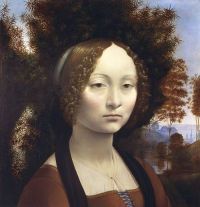
- Enlarge
- Zoom & explore
- © National Gallery of Art, Washington
Portrait of Ginevra de' Benci 1476-78
Leonardo painted this portrait of Ginevra de’ Benci while still working in the workshop of Verrocchio in Florence.
The sitter has been identified from historical sources and by the Juniper bush (ginepro in Italian) seen behind her, which is thought to be a pun on her name. The Juniper is also a symbol of female virtue and this theme is continued on the reverse of the panel, where on a background of imitation red porphyry marble, Juniper, laurel and palm leaves are interwoven by a garland with the words VIRTUTEM FORMA DECORAT: “Beauty adorns Virtue”.
The front and back of the panels are closely linked as Ginevra’s beauty is to be understood as an expression of her virtue. The panel may have been cut at some point along the lower edge, where Ginevra’s hands may once have been. A drawing of hands now in the Royal Collection, Windsor, is thought to be related to this painting, and may give some idea of the original design.
- Medium Oil on panel with addition at bottom edge
- Size 42.7 x 37 cm
- Location National Gallery, Washington

